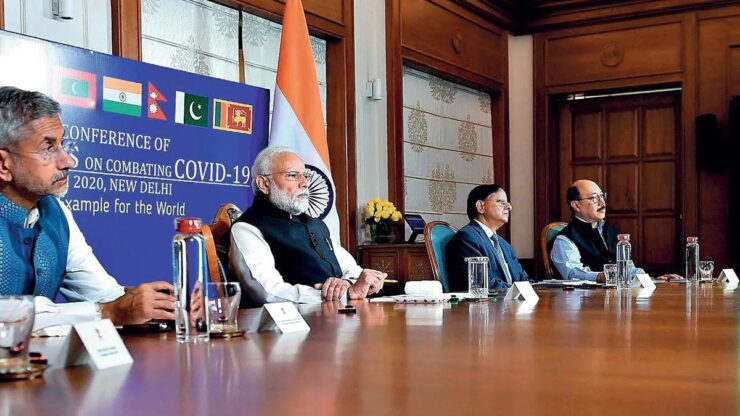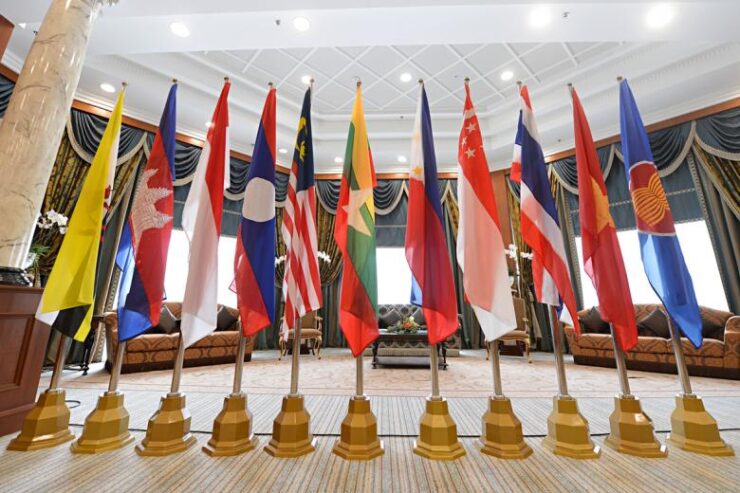
South Asia, as a geographical entity, includes India, Pakistan, Bangladesh, Sri Lanka, Afghanistan, Nepal, Bhutan and Indian Ocean island nation—Mauritius. It is hemmed in between the two troublesome regions of the world. Middle East (Gulf region) is on the West and South China Sea Nations on the East. These two flanking regions of South Asia are crisis prone, with their cascading effect on the subcontinent.
On December 8, 1985, at the initiative of India, South Asian group of nations had collectively formed a regional association called SAARC (South Asian Association for Regional Cooperation). It’s primary objective was to promote peace, trade and economic growth within the region. However over the last few years, this organisation is in a suspended animation due to sour relations between two major nations of South Asia, namely, India and Pakistan. The thaw between these two nations, holds the key to peace in South Asia.
SAARC comprises 3% of the world’s area, 21% of the world’s population and 4.21% (USD 3.67 trillion) of the global economy, as of 2019. However, it has not taken off as was expected and peace remains a distant dream. Even volume and scale of trade has not made a much headway in the last 37 years.
South Asia is in turmoil today. Sri Lanka has run into serious economic and political crisis. Pakistan is jealously following Sri Lanka route. Afghanistan has been a sick state for almost four decades. Nepal and Bhutan face “salami-slicing” of their territories by China. India and Bangladesh have serious internal security problems, aided and abetted from outside. Instability and disturbed situation in South Asia, not only causes socio-political unrest and mutual animosity but it also leads to negative growth and development.
Is peace and development a pipe dream in South Asia? No, it is not. It can be insured, if India and Pakistan reconcile with each other. This is why SAARC has gone into suspended animation. Therefore, it ought to
be acknowledged that peace in South Asia was held hostage by bitterness in relationship between India and Pakistan. It suffers from mutual distrust and deeper animosity, which dates back to the partition of British India in 1947.
Pakistan’s erstwhile Foreign Minister Mr. Kasuri, during the launch of his book, ” Not a Hawk, Not a Dove” in India, a few years back, hinted at the contours of reconciliation between India and Pakistan, based on the ground realities of 2015. In his words, “We can not take Indian Kashmir and you cannot POK,” he brought out the harsh reality. This realisation is a recognition of the overriding fact that the bottom lines of two sides ought to be abandoned. The bottom lines of the the two pivot around Kashmir i.e. Pakistan harping about the “UNFINISHED AGENDA OF 1947” and India stressing upon the theme , “KASHMIR WAS THE INSEPARABLE LIMB (ATOOT ANG) of India”.

It is against the background of the uncompromising stands of these two nations, a number of times, I have been asked as to what was the way forward? Amongst various options, I have recommended formation of SANU (South Asian Nations Union ), though it may not happen in the next 7-8 decades. Present day emotional animosity in India and Pakistan is a big hurdle for its coming into being. It is primarily due to scars of partition, which caused not only physical but emotional injuries. And Kashmir is one such issue which ferments emotional frenzy on both sides of the border. The only way of moving forward is for India and Pakistan to put Kashmir on a back burner and let status quo prevail for next 80 years. (I have given the rationale in my Book , “Kashmir – a Different Perspective”, published by Turning Point, India in March 2017).
The problem on the Indian side is that Kashmiri political leaders are playing double game. They are fooling their people. In fact, while politicians have flourished on the monetary doles from both sides, it is the general public who has not benefitted from subsidies and other economic assistance given to Jammu & Kashmir. General public, in general, is NOT anti -India. Most of them have been kept silent on gun point. Political leaders of Kashmir patronise extremists to stay in power. If Kashmir issue was resolved then Kashmiri politicians and Pakistan army would lose rationale for their existence.
On the Pakistan side, it’s army has been basically keeping the Kashmir pot boiling, so as to keep their hold over Pakistan. Therefore the problem is two folded; one, Kashmiri political leaders and two, Pakistan Army. These two elements are the enemy of peace in South Asia. An editor of Express Tribune, Shaheen had observed a few years back that these stake holders were not fools to run out of business. So the pot is kept boiling. However, I feel peace will come, but at the end of this century, till then India and Pakistan would keep wrestling in the Kashmir wrestling arena. But SANU is the only way to achieve peace in South Asia.
I dream of SANU (South Asian Nations union), like EU (European Union) or ASEAN (Association of South East Nations) by the end of 21st Century. It would include not only seven SAARC countries but also Afghanistan, Myanmar and Thailand— and even Kampuchea (Cambodia) at a later date.
The region is full of natural resources, always exploited by outside forces. It is alleged that in 200 years of British Rule, undivided India was denuded of assets worth $45 trillion. History tells me that the region has not only been deliberately divided but also kept poverty stricken. Religious and regional chasms had been created to pit one against the other to engage them in mutually exclusive conflicts, while outsiders looted its natural resources. Region had long shaken the yokes of colonialism but it continues to be kept divided and in a state of mutual conflict. As I have stated with my reasons in my above quoted book that Kashmir problem was created by Britain to keep the region divided.

The huge natural resources and wealth of manpower of these 10 countries can turn them into a powerful economic and military power, if they tie themselves up into a loose confederation as SANU. It is not a pipe dream? It may seem so, at this moment. But future holds the key. We must know that two kinds of forces were working on the geographic profile of the world. While “individualisation”, in its variant firms, such as individuals, communities, regions and religious groups, is breaking up the “Large” and “Big” into “Small” and “Smallest”; at the same time, economic compulsions of “Smaller Units” are bringing them together to form effective cohesive groups to keep away the exploiting outsiders.
Thus, two opposing forces, centrifugal and centripetal, are at work – defining two processes of “Fusion” and “Fission” working simultaneously. While “Nation” and “Religious” concepts of the world are fighting last ditched battles to save their identity but “individualisation” and “economic needs” are blurring the boundaries in a globalised world. A churning process is on and a new world of “ECONOMIC NODES” is emerging to replace the “Nations” defined by religious and geographic boundaries.
A flattened world, stretching vertically into the outer space, is heralding an era of “Cosmic Age”. The race in the space world will start “Colonisation” of other planets. Technologically advanced, economically strong and militarily sound regions would be the “Masters of the Outer Space” of tomorrow. South Asia as well as its peripheral states have the potential to take the lead, if SANU becomes a reality.
It is very much on the cards, but the constituents must stop being errand boys of West or even China. Stand together and not stand apart to make use of your natural resources for the benefit of your own people. The bonus is that if you use your resources for your people, SANU would become the only superpower, whether on the earth or in the outer space.
-An ex-NDA and Wellington Staff College graduate, Col Rajinder Singh is a renowned author and security analyst. He has authored four books, two individually and two in collaboration. His best-selling books are Kashmir – A Different Perspective and The ULFA Insurgency. The views expressed are of the author and do not necessarily reflect the views of Raksha Anirveda








